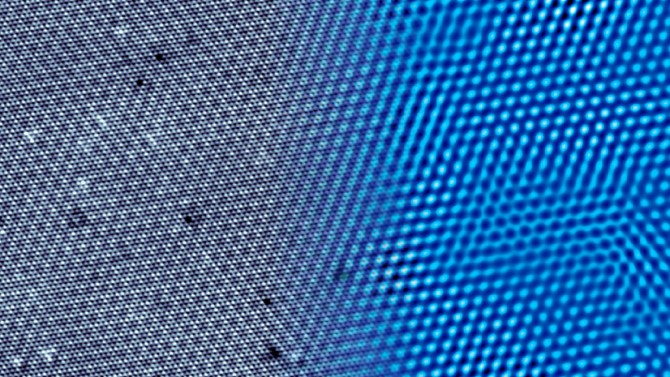In 2016, physicist J.C. Séamus Davis discovered an elusive state of quantum matter in the cuprates, which are copper oxide materials laced with other atoms. That launched a new sub-field in the study of quantum materials.
But whether this was a unique phenomenon in the cuprates or a universal and important property of nature remained unknown – until now.
This composite image shows where the selenium atoms reside in the crystal of niobium diselenide, a transition metal dichalcogenide, using conventional scanned tunneling microscopy (left, in grey) and where the electron pairs are observed using scanned Josephson tunneling microscopy (right, in blue).
Using an improved version of the radically new quantum microscope technology he developed for this purpose, Davis and his team have now found the same exotic state of quantum matter in a widely used and conventional type of material, the transition metal dichalcogenides (TMD).
Their paper, “Discovery of a Cooper-pair Density Wave State in a Transition-metal Dichalcogenide,” published June 25 in Science. Co-authors include Cornell postdoctoral fellows Xiaolong Liu and Yi Xue Chong, and Rahul Sharma, Ph.D. ’20, a postdoc at the University of Maryland.
Cooper-pair density waves are a form of exotic quantum matter in which pairs of electrons – instead of forming a conventional “superconductor,” where all are in the same freely moving state – freeze into an electron-pair crystal, also known as a pair density wave (PDW) state.
The discovery that PDWs exist in standard materials like TMDs is exciting, Davis said, because they provide a rich platform for discovery of new states of quantum matter and for development of new technologies.
“The study of TMD materials has recently become one of the hottest topics in condensed matter physics,” said Davis, the James Gilbert White Distinguished Professor Emeritus of physics in the College of Arts and Sciences (A&S), who also holds professorships at the University of Oxford, in England, and University College Cork, in Ireland. “There are hundreds of these materials in the world and they’re very widely used in technology or research, including by several groups at Cornell.”
Davis broke his own record for spatial resolution with the scanning Josephson tunneling microscope he invented, improving it in this study by a factor of about 100 (from nanometers down to around 10 picometers). He also increased the imaging efficiency by a factor of about 250, reducing Josephson junction array image acquisition times from a month down to a few hours.
Because the microscope is extremely sensitive to vibrations and to acoustic and mechanical noise and is thus designed to operate with no human beings in the lab, Davis said that the pandemic had minimal impact on its use for the research.
“If all preparations are made correctly, you press the button and the microscope very quietly does its work with nobody in the lab. The microscope stores the image and alerts you when it’s done,” said Davis. “Each individual experiment is roughly 10 days, though the whole experimental campaign takes years.”
The TMD discovery will be a boon to the many physicists at Cornell doing groundbreaking quantum materials research, Davis said, “including theorists like Eun-Ah Kim [professor of physics in A&S], whose theories on this exotic state of matter can now be subjected to experimental tests.”
The work was funded by the Gordon and Betty Moore Foundation, which Davis said also funded the development of the scanning Josephson tunneling microscope when no one else would.
“It was believed that such a microscope was extremely difficult if not impossible to implement,” said Davis, “but the Moore Foundation took the risk. They deserve a great deal of the credit for this new quantum matter visualization technology.”






